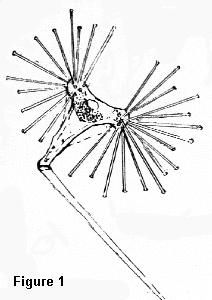 Notes on the image:
Notes on the image:Head of sucking tentacles form almost a complete ball. There are a lot of out of focus suckers coming forward and going away from the viewer.
During 1988, I constructed a very
small pond in our garden, it is not intended as a fish pond; its
main purpose is to provide a place to receive water from tarn,
loch, lake, ditch etc, after I have finished examining a good
proportion of it under the microscope - water from habitats all
over Britain collected and sent by friends or collected myself. I
realise of course, that the water in my pond will not always be
chemically suited for the flora and fauna in the containers that
I empty into it, but at least it has a chance to survive.
Many members of the PMS will know that my main interest is in freshwater algae, particularly the desmids. However I am not averse to examining in some detail any interesting fauna I find when searching slides. I am naturally particularly interested in any invertebrates that may be feeding on desmids, (see Brook and Ells, 'Microscopy', vol 35, part 7 1987). In 1989 a friend who has an established pond about a mile away, gave us a water iris for my little pond. He brought this along in a plastic bag of which was a couple of teaspoons of nice green water, in which I found several specimens of a sedentary rotifer, all new to me.
SUCTORIA
 Notes on the image:
Notes on the image:
Head of sucking tentacles form almost a complete ball. There are
a lot of out of focus suckers coming forward and going away from
the viewer.
From Wrattens pond 18th Jan 1989.
Suctoria Family Acinetina.
Tentacles 35 - 40 microns long.
Family Trichophryidae also in sample; irregular in shape, body no
stalk, tentacles up to 450 microns.
Suctoria belong to the class of ciliated animalcules, phylum
Ciliophora. In the adult state they are aciliate (without cilia),
attached with or without a stalk, and immobile, so they are also
acineta. Multiplication is by budding and the detached buds are
completely ciliated. Suctoria feed by sucking dry ciliates caught
on their sticky tentacles (I did not see any caught). The
specimen figured is Acineta lacustris (the word lacustris
means pertaining to lakes) usually attached plants (Figure 1).
Other specimens in the water were almost certainly Tricophyra epistylidis. Both species inhabit freshwater only. There are about 45 genera and many species. There are other phyla that are marine.
References
'Protozoa' Albert Westphal 1976.
'How to Know the Protozoa' Jahn, Bovee and Jahn 1949.
'Freshwater Life' John Clegg 1952, revised 1974.
Editor's note
The Micscape Editor thanks William Ells for contributing this
article, which first appeared in Balsam Post the quarterly
magazine of the Postal Microscopical Society, UK. Note that Bill
Ells has written a number of articles on desmids which are an
attractive and fascinating algae, including an Introduction
to the Desmids. All
these articles can be found in our Articles
Library in the
Pond-life section.
There is another article on a Suctorian called Podophyra written by Mike Samworth in the Articles Library.
Please report any Web problems
or offer general comments to the Micscape Editor,
via the contact on current Micscape Index.
Micscape is the on-line monthly
magazine of the Microscopy UK web
site at Microscopy-UK